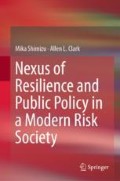Abstract
This chapter provides a framework for assessing resilience-based public policy/approaches by synthesizing key findings and insights for resilience-based public policy/approaches presented in previous chapters, which can be applied to projects or programs by multi-stakeholders at diverse scales in different contexts. Given that numerous resilience assessment frameworks and indexes/indicators have recently emerged, this chapter articulates how resilience-based public policy/approaches assessment framework (RB-PP/AAF) can contribute to existing resilience assessment frameworks or other relevant mechanisms for analysis. Specifically, the chapter outlines (1) what the RB-PP/AAF is and how it can address “missing links” with regard to existing resilience assessment frameworks, (2) what the assessment components of the RB-PP/AAF are and how they are linked with each other, and (3) how the RB-PP/AAF is applicable to projects or programs that address challenges in a modern risk society.
Access this chapter
Tax calculation will be finalised at checkout
Purchases are for personal use only
References
Beccari, B. (2016). A comparative analysis of disaster risk, vulnerability and resilience composite indicators. PLoS currents, 8.
Carpenter, S., Walker, B., Anderies, J. M., & Abel, N. (2001). From metaphor to measurement: resilience of what to what? Ecosystems, 4(8), 765–781.
Cutter, S. L. (2016). The landscape of disaster resilience indicators in the USA. Natural Hazards, 80(2), 741–758.
Cutter, S. L., Barnes, L., Berry, M., Burton, C., Evans, E., Tate, E., et al. (2008). A place-based model for understanding community resilience to natural disasters. Global Environmental Change, 18(4), 598–606.
Intergovernmental Panel on Climate Change. (2012). Managing the risks of extreme events and disasters to advance climate change adaptation. https://www.ipcc.ch/pdf/special-reports/srex/SREX_Full_Report.pdf. Accessed March 10, 2018.
Matyas, D., & Pelling, M. (2015). Positioning resilience for 2015: The role of resistance, incremental adjustment and transformation in disaster risk management policy. Disasters, 39.
Pahl-Wostl, C. (2009). A conceptual framework for analysing adaptive capacity and multi-level learning processes in resource governance regimes. Global Environmental Change, 19(3), 354–365.
Parsons, M., Glavac, S., Hastings, P., Marshall, G., McGregor, J., McNeill, J., … & Stayner, R. (2016a). Top-down assessment of disaster resilience: a conceptual framework using coping and adaptive capacities. International Journal of Disaster Risk Reduction, 19, 1–11.
Parsons, M., Morley, P, et al. (2016b). The Australian natural disaster resilience index:conceptural framework and indicator approach. Bushfire and Natural Hazards CRC. https://www.bnhcrc.com.au/publications/biblio/bnh-2585. Accessed April 3, 2018.
Plattner, H. (2010). An introduction to design thinking. Process guide. https://dschool-old.stanford.edu/sandbox/groups/designresources/wiki/36873/attachments/74b3d/ModeGuideBOOTCAMP2010L.pdf. Accessed March 10, 2018.
Schipper, E. L. F., & Langston, L. (2015). A comparative overview of resilience measurement frameworks. London: Overseas Development Institute.
Twigg, J. (2007). Characteristics of a disaster-resilient community: A guidance note to the DFID DRR Interagency Coordination Group. London: The Benfield UCL Hazard Research Centre.
Author information
Authors and Affiliations
Corresponding author
Rights and permissions
Copyright information
© 2019 Springer Nature Singapore Pte Ltd.
About this chapter
Cite this chapter
Shimizu, M., L. Clark, A. (2019). Resilience-Based Public Policy/Approaches Assessment Framework. In: Nexus of Resilience and Public Policy in a Modern Risk Society. Springer, Singapore. https://doi.org/10.1007/978-981-10-7362-5_7
Download citation
DOI: https://doi.org/10.1007/978-981-10-7362-5_7
Published:
Publisher Name: Springer, Singapore
Print ISBN: 978-981-10-7361-8
Online ISBN: 978-981-10-7362-5
eBook Packages: Political Science and International StudiesPolitical Science and International Studies (R0)

